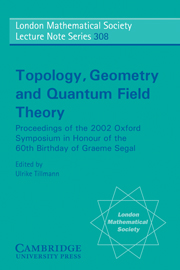 Topology, Geometry and Quantum Field Theory
Topology, Geometry and Quantum Field Theory Book contents
- Frontmatter
- Contents
- Preface
- Participants
- Introduction
- Part I Contributions
- 1 A variant of K-theory: K±
- 2 Two-vector bundles and forms of elliptic cohomology
- 3 Geometric realization of the Segal–Sugawara construction
- 4 Differential isomorphism and equivalence of algebraic varieties
- 5 A polarized view of string topology
- 6 Random matrices and Calabi–Yau geometry
- 7 A survey of the topological properties of symplectomorphism groups
- 8 K-theory from a physical perspective
- 9 Heisenberg groups and algebraic topology
- 10 What is an elliptic object?
- 11 Open and closed string field theory interpreted in classical algebraic topology
- 12 K-theory of the moduli space of bundles on a surface and deformations of the Verlinde algebra
- 13 Cohomology of the stable mapping class group
- 14 Conformal field theory in four and six dimensions
- Part II The definition of conformal field theory
- Foreword and postscript
- The definition of CFT
- References
11 - Open and closed string field theory interpreted in classical algebraic topology
Published online by Cambridge University Press: 06 November 2009
- Frontmatter
- Contents
- Preface
- Participants
- Introduction
- Part I Contributions
- 1 A variant of K-theory: K±
- 2 Two-vector bundles and forms of elliptic cohomology
- 3 Geometric realization of the Segal–Sugawara construction
- 4 Differential isomorphism and equivalence of algebraic varieties
- 5 A polarized view of string topology
- 6 Random matrices and Calabi–Yau geometry
- 7 A survey of the topological properties of symplectomorphism groups
- 8 K-theory from a physical perspective
- 9 Heisenberg groups and algebraic topology
- 10 What is an elliptic object?
- 11 Open and closed string field theory interpreted in classical algebraic topology
- 12 K-theory of the moduli space of bundles on a surface and deformations of the Verlinde algebra
- 13 Cohomology of the stable mapping class group
- 14 Conformal field theory in four and six dimensions
- Part II The definition of conformal field theory
- Foreword and postscript
- The definition of CFT
- References
Summary
Abstract
There is an interpretation of open–closed string field theory in algebraic topology. The interpretation seems to have much of the expected structure but notably lacks the vacuum expectations. All the operations are defined by classical transversal intersection of ordinary cycles and homologies (derived from chains in path spaces) inside finite-dimensional smooth manifolds. The closed string theory can be deduced from the open string theory by the known equivariant chain or homology construction. One obtains the interpretation of open and closed string field theory combined. The algebraic structures derived from the first layer of open string interactions realize algebraic models discussed in work of Segal and collaborators. For example Corollary 1 of §11.1 says that the homology of the space of paths in any manifold beginning and ending on any submanifold has the structure of an associative dialgebra satisfying the module compatibility (equals Frobenius compatibility). See the appendix for the definition of six kinds of dialgebras. Corollary 2 gives another dialgebra structure which is less known. Corollary 3 gives yet another, the Lie bialgebra of.
Open string states in M
The open string theory interpretation in topology takes place on the homology or on the chain level–referred to respectively as ‘on-shell’ and ‘off-shell’. Onshell there will be a linear category [ϑM] for each ambient space M, a finite dimensional oriented smooth manifold possibly with general singularities.
- Type
- Chapter
- Information
- Topology, Geometry and Quantum Field TheoryProceedings of the 2002 Oxford Symposium in Honour of the 60th Birthday of Graeme Segal, pp. 344 - 357Publisher: Cambridge University PressPrint publication year: 2004
- 18
- Cited by


